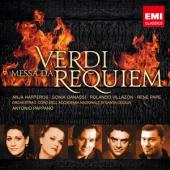| Label: WARNER CLASSICS (EMI)
Catalog: 5099969893629
Format: CD Anja Harteros, Sonia Ganassim Rolando Villazón, René Pape / Orchestra e Coro dell’Accademia di Santa Cecilia, Antonio PappanoVerdi: Messa da Requiem 2010 Gramophone Award Winner: Best Choral Recording
Following the release of his critically acclaimed recording of Madama Butterfly, Music Director Antonio Pappano returned to the Orchestra and Chorus of the Accademia Nazionale di Santa Cecilia in January 2009 for performances of Verdi’s spectacular Requiem with stellar soloists Anja Harteros, Sonia Ganassi, Rolando Villazón and René Pape. EMI Classics microphones were at hand to record the concerts. Reviewing one of the performances, Hugh Canning wrote in The Sunday Times, “To hear Italians in this great music is nearly always a special treat. It is in their blood, and their native empathy, combined with the discipline of Pappano’s American and northern European training, made for a gripping occasion, a performance of enthralling beauty and visceral thrills.” Mya Tannenbaum of the Corriere della Sera said, “It was certainly an unforgettable emotional journey. … Pappano was more emotional than ever but controlled, a great master of contrasts and silences.” In the words of Antonio Pappano, himself born to Italian parents, “this is a Requiem written by an Italian and I think Italians’ relationship to religion is explosive, full of temperament, full of fear. …. And the spectre of being punished, of sins – it sounds like an opera I’m describing. …I love doing this piece here in Rome with an Italian chorus and an Italian orchestra, and they have an innate sense of what this music is about, how to bring it to life. They really know what the words mean. They have lived what it is to be religious or spiritual in Italy.” Addressing Hans von Bülow’s remark that Verdi’s Requiem is “an opera dressed in ecclesiastic clothes,” Pappano says, “The music is written in a way that requires real singers, used to singing Verdi in the opera house. … They have to be a very high level of musician, because they are often singing a cappella, the music is quite sophisticated, harmonically speaking quite technically difficult. The singers’ sense of taste and refinement has to be elevated. It’s easy to become vulgar in this music, and this must never happen.” Interviewed at the time of the performances, Rolando Villazón discusses the same subject: “Many say that this is the best opera Verdi ever wrote. Clearly it’s not … but the theatricality of the piece requires something more than what you would use for an oratorio … It’s a very delicate balance singers have to have. … You have to respect the style of this church piece, and at the same time you have to bring out the emotion.” To that end, Antonio Pappano brings out the extremes of dynamics in the orchestral, solo and chorus parts: the opening, one of Pappano’s favourite sections, is hushed and what Canning describes as “the great ‘horror’ moments [send] shivers down the spine.” Giuseppe Verdi composed the requiem to commemorate the life of the great Italian novelist, poet and statesman Alessandro Manzoni. Verdi revered him and, with the rest of Italy, was disconsolate when the writer died in May 1873. The composer started with a slightly altered version of the Libera me score that he had previously contributed to a mass honouring Rossini, of which different sections had been assigned to various composers. The Messa per Rossini, however, was never performed. Verdi retrieved the Libera me and proceeded to compose the six remaining sections to complete the requiem for Manzoni. The composer conducted the premiere on the anniversary of Manzoni’s death, in the same church where his state funeral had taken place. |

 Price: $23.98
Price: $23.98










